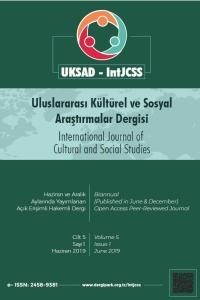Judeo-Spanish and Turkish Proverbs and Idioms with Djoha and Hodja Nasrettin: Questioning Wittiness via Conceptual Metaphors
Cognitive Linguistics, Conceptual Metaphors, Nasrettin Hodja effects of the Ottoman culture on Turkish Sephardim,
___
- Avcıkurt, A. (1993). Non-Regional Variation in Present-Day Judeo-Spanish in Istanbul, Unpublished Ph.D. thesis, Hacettepe University, English Linguistics, Ankara, 1993.
- Bardavid, B. (1997). Bizim Hoca - Nasreddin Hoca, Toplumbilim (6), 87 - 96.
- Clewlow, D. F. (1990). Judeo-Spanish: An Example from Rhodes. Unpublished M.A. thesis, University of British Columbia, Hispanic and Italian Studies, British Columbia.
- Duymaz, Recep. (2005). Atalar Sözü, Istanbul, Bilimevi Basın Yayın Ltd. Şti.
- Harris, T. (2005). What Language Did the Jews Speak in Pre-Expulsion Spain? In G. K. Zucker (Ed.), Sephardic identity: Essays on a vanishing Jewish culture (pp. 99-111). Jefferson, North Carolina & London: McFarland & Company, Inc. Publishers.
- Koen – Sarano, Matilda. (1991). Djoha Ke Dize? Kuentos Populares Djudeo-Espanyoles, Jerusalem, Kana.
- Kövecses, Z. (1995). The “Container” Metaphor of Anger in English, Chinese, Japanese, and Hungarian. In Z. Radman (Ed.), From a Metaphorical Point of View: A Multidisciplinary Approach to the Cognitive Content of Metaphor (pp. 117 – 145.). Berlin & New York: Walter de Gruyter.
- Kövecses, Z. (1988). The Language of Love. Lewisburgh: Associated University Press.
- Kövecses, Z. and Szabcó, P. (1996). Idioms: A View from Cognitive Semantics, Applied Linguistics, 17 (3), 326 - 355.
- Lakoff, G. and Johnson, M. (1980). Metaphors We Live By. Chicago, The University of Chicago Press. Püsküllüoğlu, Ali. (1998) Türkçe Deyimler Sözlüğü, Ankara, Arkadaş.
- Radden, G. and Kövecses, Z. (1999). Towards a Theory of Metonymy. In K.-U. Panther & G. Radden (Eds.), Metonymy in language and thought (pp. 17 – 60). Amsterdam: J. Benjamins Pub.
- Sansal, B. (2007). Nasreddin Hodja. Retrieved November 06, 2007, from: http://www.allaboutturkey.com/nasreddin.htm
- Sarhon, K. (n. d.). Judeo-Spanish Language and Culture. Retrieved March 01, 2006, from Sephardic Center: http://www.istanbulsephardiccenter.com/index.php?contentId=41&mid=31
- Ungerer, F. and Schmid, H. J. (1997). An Introduction to Cognitive Linguistics, London & New York, Longman.
- Yu, N. (2003). Metaphor, Body, and Culture: The Chinese Understanding of Gallbladder and Courage. Metaphor and Symbol, 18 (1), 13 - 31.
- Başlangıç: 2015
- Yayıncı: Mutlu TÜRKMEN
İletişim Fakültesi Ders Müfredatlarının Sektörün Nitelikli İşgücü Talebine Uyumu
Ali BÜYÜKASLAN, Korhan MAVNACIOĞLU
Farklı Yaş Gruplarındaki Lisanslı Tenisçilerin Görsel ve İşitsel Reaksiyon Zamanlarının İncelenmesi
Ender EREN, Recep Sürhat MÜNİROĞLU, Uğur ÖZER
Rajab İdd MUYINGO, Ali Murat KIRIK
Ali Fuat ERSOY, Mustafa HURASAN
Arsev Ayşen ARSLANOĞLU YILDIRAN
Genç Bireylerin Turistik Tercihlerinin Belirlenmesi Üzerine Balıkesir Kent Merkezinde Bir Araştırma
Bartın Üniversitesinde Öğrenim Gören Öğrencilerin Spora Yönelik Tutumlarının Belirlenmesi
Rukiye VAROL, Serkan VAROL, Mutlu TÜRKMEN
Örgütiçi İletişim Becerilerinin İşgören Performansı Üzerine Etkileri
